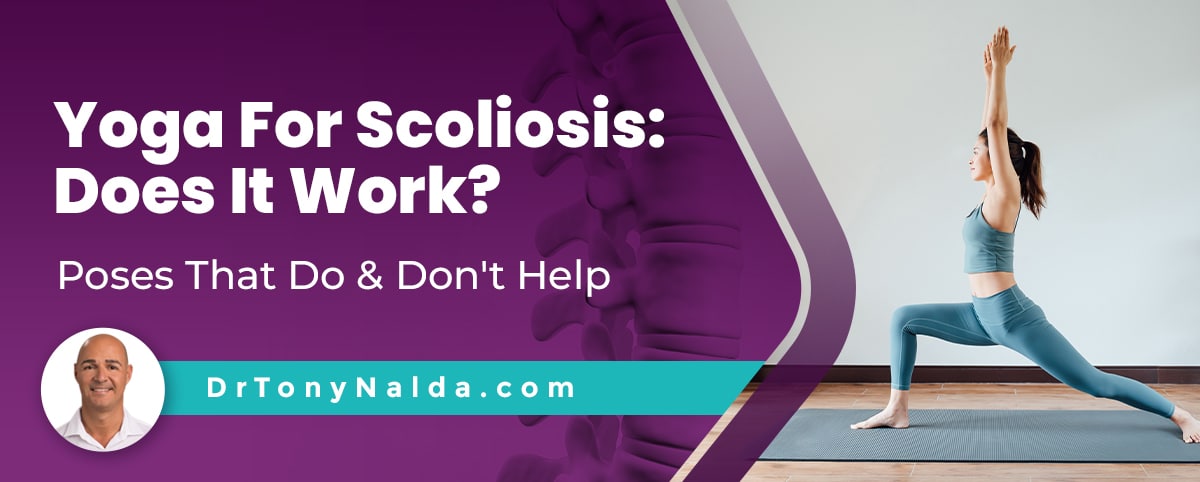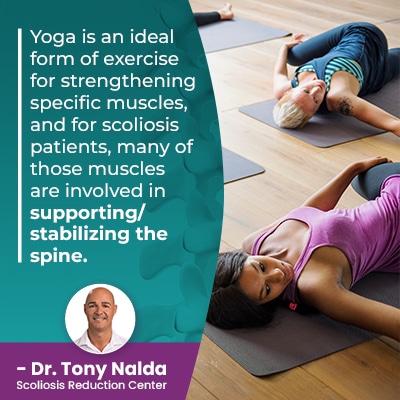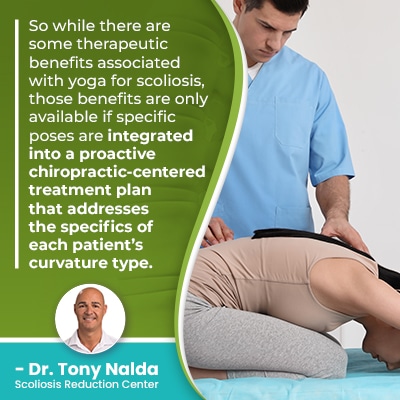Yoga For Scoliosis: Does It Work? Poses That Do & Don't Help

While any and all types of exercise have to be approved by a patient’s treatment provider, scoliosis-specific yoga can help keep the spine as strong and flexible as possible, making it more responsive to treatment. Yoga can also help address muscle imbalance, and increasing core strength means more support for the spine.
If integrated into a proactive treatment plan designed by a scoliosis chiropractor, yoga can help improve spinal strength, flexibility, and increase core strength so the spine is optimally supported by its surrounding muscles. On its own, however, yoga isn’t enough to treat scoliosis.
There was a time when the place of exercise in scoliosis treatment was questioned, but we’ve since learned that certain types of movement, like yoga, can help augment corrective results.
Table of Contents
What is Yoga?
Yoga is an ancient Indian health practice that’s been around for thousands of years and has been steadily gaining in popularity throughout the Western world.
Yoga has both physical and mental health benefits that are now supported by science; when performed properly, yoga can help reduce stress, anxiety, and inflammation, while improving balance and increasing overall strength.
But what about yoga for people with scoliosis? Is it safe to perform strenuous yoga poses for people with an unnatural sideways spinal curve? And what about treatment? Is yoga a form of treatment for scoliosis, or can it interfere with treatment?
When it comes to yoga, it’s important that patients understand the difference between doing yoga while having scoliosis, and doing scoliosis-specific yoga that’s designed as a facet of treatment.
There are scoliosis-specific yoga programs that combine the ancient practice of yoga, with scoliosis-specific treatment and care.
Let’s now explore the potential benefits of scoliosis-specific yoga that’s integrated into a proactive chiropractic-centered treatment approach.
How Yoga Can Impact Scoliosis
 Yoga is an ideal form of exercise for strengthening specific muscles, and for scoliosis patients, many of those muscles are involved in supporting/stabilizing the spine.
Yoga is an ideal form of exercise for strengthening specific muscles, and for scoliosis patients, many of those muscles are involved in supporting/stabilizing the spine.
Most yoga poses involve holding specific poses while engaging type-one, slow-twitch muscles, and long isometric stretches: improving spinal health by increasing its level of flexibility and strength.
In addition, muscles strengthened through yoga also help with posture, and we know that postural changes are among the earliest signs of scoliosis in adolescents.
When used effectively and performed as prescribed, yoga can also help provide pain relief for those experiencing it (more common in adults) and help maintain good posture.
However, what I have to be crystal clear on is that yoga on its own, does not have the power to impact scoliosis on a structural level; as a structural spinal condition, treatment has to, first and foremost, impact the condition on a structural level.
When a person has scoliosis, their spine is no longer aligned, and while no exercise, on its own, can realign a scoliotic spine, certain scoliosis-specific exercises (SSEs) and stretches can augment other forms of treatment with the power to induce structural changes, like chiropractic care.
So yoga for scoliosis, does it work? On its own, no, yoga can’t reduce a scoliotic curve on a structural level, and part of the reason is related to symmetry.
Symmetry and Yoga
Generally speaking, yoga is performed in a symmetrical manner that assumes both sides of the body are mirror images of each other, but as scoliosis introduces a lot of uneven forces to the body, that isn’t always the case.
The condition’s uneven forces disrupt the body’s overall symmetry, and as as progressive condition, scoliosis has it in its nature to worsen over time, meaning even scoliosis diagnosed as mild is likely to worsen at some point.
So structurally reducing scoliosis is beyond the scope of yoga, and any form of exercise for that matter, as yoga operates under the assumption that the body is symmetrical, which isn’t often the case for people with scoliosis.
Even if a patient has mastered a number of yoga poses and can perform them precisely as prescribed, asymmetrical motion has occurred in the spine as it’s no longer moving in the same way in either direction, which can actually exacerbate condition-related issues.
For example, if a patient is trying to work the biceps of each upper arm symmetrically, but one arm has a limited range of motion due to an unrelated elbow injury, even if performing the bicep curls exactly the same by each arm, only one will reap the full benefits; yoga for scoliosis is similar as the spinal muscles don’t have equal strength and/or function on each side of the spine.
So due to asymmetrical joint motion, yoga is minimally effective when it comes to reducing a scoliotic curve, so can’t achieve corrective results, and some yoga poses can actually exacerbate scoliosis symptoms, particularly those that overuse one side of the body, place the back in an unnatural arch, or involve hyperextending the spine.
So to summarize, yoga can offer some scoliosis-related benefits in terms of improving overall physical strength, core strength, spinal flexibility, and mental health: known to better equip the body to deal with the rigors of treatment.
For those wondering if yoga works for scoliosis, as a sole form of treatment, it won’t be effective, so let’s now move on to some yoga poses that work, and don’t work, for scoliosis.
Yoga Poses that Help Scoliosis
The main goal for scoliosis-specific yoga is to improve a patient’s mobility, strength, and manage pain; particularly when combined with other scoliosis-specific exercises and treatment disciplines, there are certain yoga poses that can help.
Before any yoga poses are added into an effective scoliosis exercise regime, certain factors such as the patient’s curvature location and pattern have to be considered as each case of scoliosis is unique.
By customizing yoga poses to suit the specifics of each condition, poses that exacerbate symptoms and/or interfere with treatment are avoided.
Patients, and those recommending certain yoga poses for scoliosis, have to be aware of their curvature pattern and angle of trunk rotation (ATR); that way, the correct poses with potential to make improvements can be selected.
If deemed appropriate for a particular patient’s condition, the following yoga poses can be helpful:
- Side plank
- Mountain pose
- Downward dog
The Side Plank
A side plank can help with asymmetrical strengthening, and the pose involves lying on one side with the legs extended while the head remains aligned with the spine.
The hips and knees are lifted from the floor while pushing up with the arm. Engage the core, and make sure the torso is straight and in alignment with the rest of the body.
The arm and core will support the weight of the body, and sides can be alternated.
Holding the pose and posture on the convex side of the spine helps strengthen the convex side of the curve’s abdominal/spinal muscles that, theoretically, bend the spine away from the stronger side to improve spinal strength.
While there are some schools of thought that assert the side plank performed a certain number of times daily can actually reduce a patient’s Cobb angle, studies don’t support this and claim the benefits of side planking are more indirectly related to increasing muscle and spinal strength, more so than actually reducing a scoliotic curve.
Mountain Pose
The mountain pose helps promote good posture, balance, and increases core strength.
The pose starts by standing with the feet aligned with the hips and the shoulders loose and relaxed.
While tightening the thigh muscles, keep the feet firmly on the ground, while extending the toes up and down.
Shifting weight between the balls of the feet and the heel can improve balance while engaging the core.
Downward Dog
The downward dog is started in a plank position with the hands flat on the floor and the arms outstretched straight in front.
Push the hips back and up into an upside down ‘V’ shape, then pull the hips back down towards the floor while taking deep breaths.
When performed correctly, the downward dog can help reduce spinal strain by lengthening the spine while the body’s weight is evenly distributed onto the lower body (legs).
With practice, the pose can help with pain and discomfort caused by stiff muscles and spinal rigidity as it increases flexibility.
Now that we’ve touched on a few yoga poses that help scoliosis, let’s briefly explore some that don’t.
Yoga Poses that Don’t Help Scoliosis
As mentioned, while some yoga poses can be helpful for scoliosis in terms of pain relief, increasing core/spinal strength and flexibility, others can actually exacerbate symptoms and interfere with treatment.
When it comes to determining which yoga poses help versus those that hinder, the answer is case-specific, but generally, poses that involve bending backwards, hyperextending the middle back (thoracic spine), such as the cobra and locust can actually increase the size of a scoliotic curve while in the pose.
In addition, poses that involve twisting the torso aren’t helpful as when the shoulders and rib cage are twisted against the pelvis, the motion can increase the rotation that characterizes a scoliotic spine.
Poses like the triangle and seated twist can also be harmful for scoliosis because they involve the rig cage being unnaturally bent, which can exacerbate the condition’s asymmetrical effects on the rib cage: development of a rib arch.
The shoulder stand is another yoga pose to avoid because it bends the head forward at a sharp angle, which overextends the neck muscles and increases the weight of the head on the cervical spine and shoulders.
 So while there are some therapeutic benefits associated with yoga for scoliosis, those benefits are only available if specific poses are integrated into a proactive chiropractic-centered treatment plan that addresses the specifics of each patient’s curvature type.
So while there are some therapeutic benefits associated with yoga for scoliosis, those benefits are only available if specific poses are integrated into a proactive chiropractic-centered treatment plan that addresses the specifics of each patient’s curvature type.
Conclusion
Yoga’s track record, in terms of its potential physical and mental health benefits, speaks for itself with a number of scientifically-backed benefits, including increasing core strength and flexibility.
For those living with scoliosis, yoga can provide the indirect benefit of helping patients better deal with the rigors of treatment, staying strong and flexible, and providing pain relief.
It’s important to understand, however, that relying on yoga for scoliosis as the sole form of treatment will be ineffective.
As scoliosis is a structural condition, effective treatment has to impact it, first and foremost, impact the condition on a structural level by realigning the spine and restoring its healthy curves, and this is simply beyond the scope of yoga, or any form of exercise for that matter.
When performed as prescribed and when customized to a patient’s condition by an expert, yoga poses can help scoliosis indirectly by creating an environment within the body that's conducive to healing; however, no yoga pose has the power to induce a structural change.
So while certain yoga poses can help provide pain relief while increasing spinal flexibility and core strength, they can’t reposition the vertebrae so aren’t adequate as a form of treatment.
In addition, certain yoga poses can make symptoms worse; poses that twist the torso, bend the spine backwards, hyperextend the middle back, unnaturally bend the head forward, and/or bend the rib cage.
Here at the Scoliosis Reduction Center, every treatment plan is fully customized to address the specifics of their condition, and any form of exercise integrated into treatment plans are scoliosis-specific.
Dr. Tony Nalda
DOCTOR OF CHIROPRACTIC
After receiving an undergraduate degree in psychology and his Doctorate of Chiropractic from Life University, Dr. Nalda settled in Celebration, Florida and proceeded to build one of Central Florida’s most successful chiropractic clinics.
His experience with patients suffering from scoliosis, and the confusion and frustration they faced, led him to seek a specialty in scoliosis care. In 2006 he completed his Intensive Care Certification from CLEAR Institute, a leading scoliosis educational and certification center.
About Dr. Tony Nalda
 Ready to explore scoliosis treatment? Contact Us Now
Ready to explore scoliosis treatment? Contact Us Now





